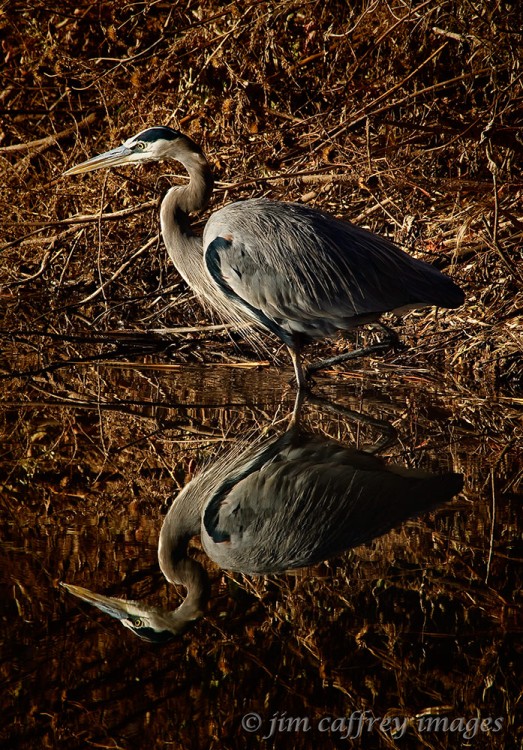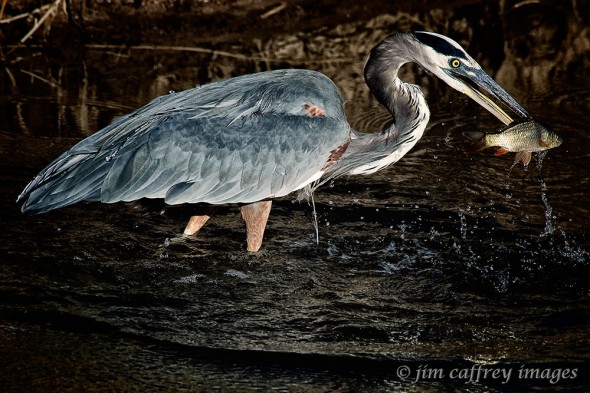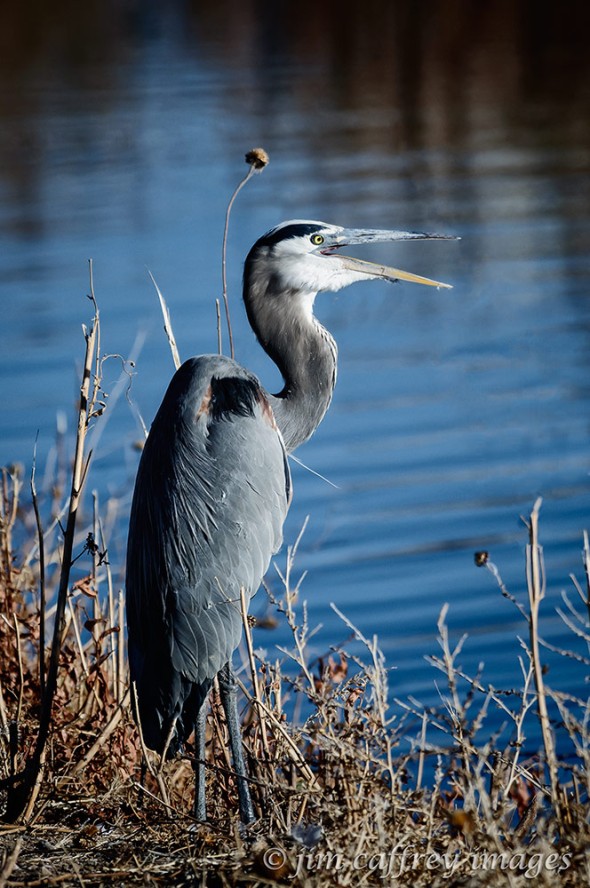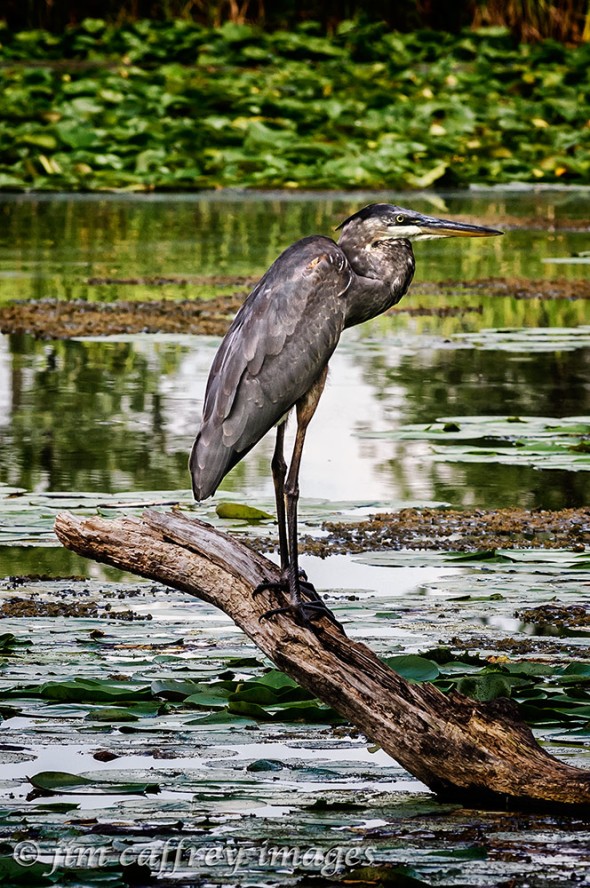Herons, Herons and More Herons
Herons are solitary birds. Unlike cranes that go about their business in large flocks, herons are found on the edge of things: walking slowly and quietly along a canal, drainage ditch or river, hunting for their dinner. Although they are monogamous, they are rarely seen out together in public.
When I make my annual pilgrimage to Bosque del Apache National Wildlife Refuge, the skies and the ponds are filled with raucous, gangly, yet somehow graceful cranes–thousands of them. The typical heron count is three or four. So, I spend a fair amount of time cruising slowly along the drainage canals looking for these elusive birds.
Sometimes, when I’m patient, I’m rewarded with a capture like the one above. I had followed this guy (girl?) for close to half an hour, moving when he moved, but giving him plenty of room. When I saw him extend his neck, I fired a continuous burst of about five exposures and this is the result.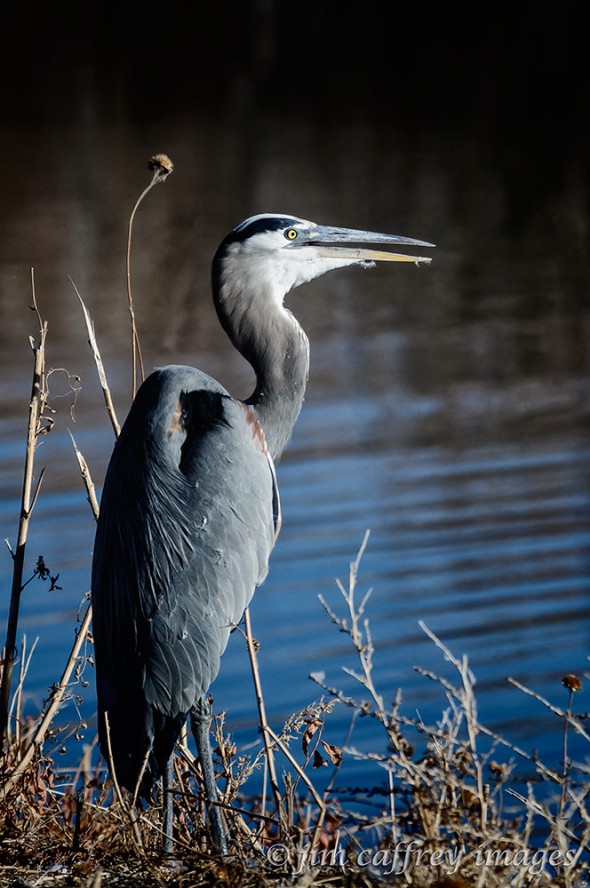
There are other times when patience has nothing to do with it. Robin and I came across this heron standing along the edge of a canal on the south side of the Flight Deck Pond. We were easily within twenty-five yards of him and he acted like we weren’t even there.
Every once in a while, he would close his eyes as if napping. After about thirty minutes we had gotten all the exposures we wanted and drove off leaving him standing there.
I made this last image while my daughter Lauren and I were walking her dog at a dog park in Madison, Wisconsin. Luckily, I was a little ahead of them and had time to warn her off. Otherwise, her dog would have been after the bird and this capture would have been lost.
The Big Wing
Somewhere out in the middle of New Mexico’s San Juan Basin, there is a piece of sandstone that sits atop a column of mudstone. Recently, it has become a kind of holy grail for landscape photographers. It has been given a name: “The King Of Wings”. I have known about this formation for a few years and have thought it would be nice to find it and photograph it, but other things kept popping up and the wing remained on the back burner.
In the spring of last year (2012) a fellow from California contacted me about booking a Photo Tour. He wanted to go to “The King Of Wings”. I told him that I didn’t know where it was, but he didn’t want to take no for an answer. So began a long distance collaboration to discover the location of this particular formation.
Over the course of the next couple of months, we corresponded by e-mail and I told him that I thought I had an idea where our prize might be. I went out to the place I suspected and made an exhaustive search, but came home tired and empty-handed. Then one day he e-mailed me with the news that he had found it on Google Earth. We made tentative plans to meet when he came to New Mexico to photograph the wing, but I was unable to join him on that trip.
Over the next six months, the wing was once again relegated to the back burner as other things took priority, but every once in a while a small voice would interrupt my train of thought telling me to go and find that damn wing.
Finally, I put a day on the calendar and made plans to make the trip (and silence the voice). Robin and I set out early on a Sunday morning and made the three and a half hour drive to the area that serves as a starting point for the walk to the wing. When we arrived, there was about six inches of snow on the ground and looking out across the white, featureless landscape, I began to have second thoughts. I consulted my GPS: 1.7 miles (as the crow flies) to the wing; we decided to go for it and set out across the rolling, snow covered plain.
Actually, the hike was more than three miles (since we are not crows and are unable to fly), not very far really, but trudging through the snow, up and down hilly terrain with camera gear and tripod is a bit different than a walk in the park. After finally coming to the wash where the landscape suddenly changed from bunch grass prairie to badlands we knew we were getting close. We skirted a rock outcrop and I consulted my GPS. I looked in the direction the little magic box indicated, and there it was, still a half mile away, but in our sights. What makes this wing special is the cantilever (12 feet) of the stone beyond the supporting column. It’s whereabouts is a closely guarded secret by those who have found it, so I will respect that and keep the secret, but I have to wonder what all the fuss is about.
The day I chose to make this long anticipated trip was clear with nothing to interrupt the agonizingly blue doldrum sky but the waxing gibbous moon. I told myself that this was an exploratory venture, that I would return on another day when the skies were more photogenic. Perhaps, perhaps not.
The last image is the obligatory wing portrait with Robin and me seated beneath the cantilever to give a sense of scale to the thing. There are other formations and hoodoos in the area, but they are really nothing special, so we packed up and hiked back to the car. Now I’m sitting here writing this and asking myself if I’m being fair. I am glad that I finally made it to the Big Wing (King of Wings seems a bit of an over-statement to me). But, in my estimation, it’s a one trick pony.
In My Yard
I live in a small village in north-central New Mexico and the Jemez River runs through my yard. There is one apple tree; I don’t harvest the apples. In the fall when they begin to ripen, the deer make my yard their own and feast on the apples.
They also come through to get to the river. There is a drainage that runs from the mesa top five hundred feet above and the deer use this as a conduit to move to and from the river which is the most reliable source of water for miles.
The deer: bucks, does, and fawns have become a regular source of enjoyment for me. Just looking out and seeing them browsing at the tree or grazing in the grasses gives me a sense of connection to them and their world–my world.
Last week while editing some images and trying to pick one to post to my Facebook page, I went to my coffee pot to pour a cup, then to the door to survey the yard. I was greeted by this majestic bull elk. There are plenty of elk in the Jemez Mountains and I’ve seen many on, or near the road, especially in the high country; but this was the first time I had seen one in my yard. He was nervous and I had to move slowly to get into position to get a decent line of sight.
I managed to make eight exposures and the two I have posted here are my picks. I hope this guy makes my place a regular stop in the future.
A Bisti Wonderland
Of all the times I’ve been to the Bisti Wilderness, this is only the third time I’ve been there with snow on the ground. To be honest, I probably wouldn’t have been there this time if I didn’t have a Photo Tour to lead. We met at the Bisti turn-off on NM 371 at 8 AM. After giving my safety briefing, we set out across the snow covered terrain.
The first stop was the Brown Hoodoos. I almost eliminated this part of the tour due to the slippery footing combined with the climb required to reach them, but once we got there, I was happy that I made the effort. The scenery more than made up for the risk and my clients were delighted.
After spending a half hour or so I decided we needed to move on. The forecast called for warmer temperatures in the afternoon and I knew that would mean the snow would melt turning the mostly-clay ground into a muddy quagmire.
We made the hike out to the Egg Garden in good time and here we spent another forty-five minutes or so. I began to realize that there were parts of the landscape that were more defined because of the snow and the contrast it provided, and other parts that seemed less photogenic because of it. The Garden was in the latter category, but my tour participants were having a great time nonetheless.
From the Egg Garden, we moved on to the Petrified Trees and here we lingered the longest. It was while we were here that the mud began to raise its ugly head.
The next stop was the Eagle’s Nest and by now we were walking in the runoff channels which was easier than walking in the ooze. This is an image of the approach to the Nest–it’s the prominent feature in the distance. You can see the muddy water flowing in the wash on the left.
We circled the Eagle’s Nest and then made our way back over to Alamo Wash which by now was running deeper than I have ever seen it run. This meant we had to start walking in the mud, but we were also at the final stop on the tour. Now all we had to do was trek close to four miles back to the parking area. I made this image in a small area of hoodoos just north of the Eagle’s Nest and began to pack up my gear in preparation for the return hike.
It was then that Tomas noticed the cranes. A flock of Sandhill cranes–probably migrating to Bosque del Apache–were battling the winds to make it to their wintering grounds, still more than two hundred miles to the southwest. They were too far away to make a good image, but you can see them (the small dots to the right of the rock formation) in this one that I made of my intrepid clients watching them fly by.
The walk out was more strenuous and it did take longer than usual due to the muddy conditions, but we laughed at our plodding and sliding most of the way out. At one point, we were all stuck on a slight incline and none of us could make any headway; the greasy caliche mud was so slick that we had to backtrack and find another route. It was a good day though. My clients came away with some good images, and I with some nice images and some good stories to tell.

